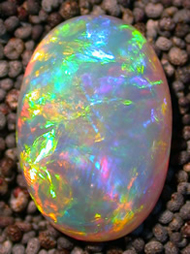Opals are Lucky!
 All the evidence demonstrates that throughout history opal has been regarded as the stone of good fortune.
All the evidence demonstrates that throughout history opal has been regarded as the stone of good fortune.
Late in the nineteenth and early in the twentieth century however, possibly for commercial reasons there was a proliferation of damaging reports that opal was an unlucky stone. These were based upon a misinterpretation: -
There can be little doubt that much of the modern superstition regarding the supposed unlucky quality of the opal owes its origin to a careless reading of Sir Walter Scott's novel ‘Anne of Geierstein'.
"The wonderful tale…contains nothing to indicate that Scott really meant to represent opal as unlucky.” (The Curios Lore of Precious Stones, by George F. Kunz)
Isidore Kozminsky in the1922 edition of his book “the Magic and Science of Jewels and Stones” states that:
“Perhaps against no other gem has the bigotry of superstitious ignorance so prevailed as against the wonderful opal.”
He also cites several historical references to the talismanic qualities of opal including the following story.
A French baron, who resided in London , owned an opal that had been in the family since the twelfth century. In 1908 he took the opal to the London Pavilion where a soothsayer told him that the opal would bring him good fortune and that he was about to inherit £500,000! The London newspaper “Evening News “ reported that within a few days the soothsayers' prediction had come true, it also stated that the ancient opal had a feint inscription in old Spanish, which translated to the words “Good Luck”.
In Roman times the gem was carried as a good luck charm or talisman, as it was believed that the gem, like the rainbow, brought its owner good fortune. It was also referred to as the “Cupid stone” because it suggested the clear complexion of the god of love.
In the 7 th century it was believed that opals possessed magical properties and centuries later Shakespeare was attributed with the description of opal as “that miracle and queen of gems”.
The Arabs believed that they fell from the sky and the Orientals referred to them as “the anchor of hope”. Lucky opal – the stone of hope, the birthstone of October.





